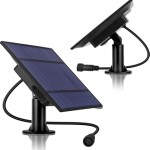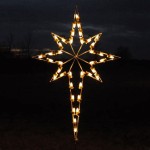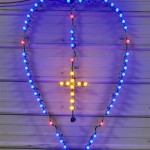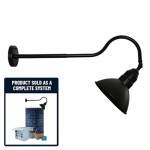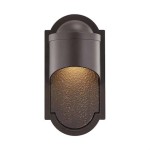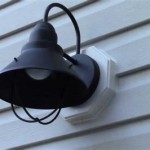Commercial LED Outdoor Wall Lighting: Illumination, Security and Efficiency
Commercial LED outdoor wall lighting is a crucial element in creating safe, welcoming, and aesthetically pleasing environments for businesses. It serves multiple purposes, from enhancing security and improving visibility to highlighting architectural features and establishing a brand identity. Given the energy efficiency, longevity, and versatility of LED technology, it has become the dominant choice for commercial outdoor wall lighting applications.
The selection and implementation of commercial LED outdoor wall lighting require careful consideration of various factors. These include the specific needs of the property, the desired lighting effect, the regulatory requirements, and the overall budget. A well-designed lighting scheme can significantly improve the functionality and appeal of a commercial space, while poorly chosen or improperly installed lighting can lead to inefficiencies, safety hazards, and an uninviting atmosphere.
This article explores the key aspects of commercial LED outdoor wall lighting, covering its benefits, common applications, design considerations, installation guidelines, and maintenance practices. It aims to provide a comprehensive understanding of this essential element of commercial property management and development.
Benefits of LED Technology for Outdoor Wall Lighting
LED (Light Emitting Diode) technology offers numerous advantages over traditional lighting options such as incandescent, fluorescent, and high-intensity discharge (HID) lamps. These benefits contribute to the widespread adoption of LEDs in commercial outdoor wall lighting applications.
One of the primary advantages is energy efficiency. LEDs consume significantly less electricity than traditional lighting sources to produce the same amount of light. This translates to lower energy bills and reduced operating costs for businesses. The difference in energy consumption can be substantial, with LEDs often consuming up to 75% less energy than incandescent bulbs and 50% less than fluorescent lamps.
Another key benefit is the longevity of LEDs. They have a much longer lifespan than traditional lighting sources, often lasting for tens of thousands of hours. This reduces the frequency of replacements, minimizing maintenance costs and labor expenses. The extended lifespan also contributes to sustainability by reducing the amount of waste generated from discarded bulbs.
LEDs are also known for their durability and resistance to environmental factors. They are less susceptible to damage from vibrations, impacts, and temperature fluctuations compared to fragile incandescent and fluorescent bulbs. This makes them well-suited for outdoor applications where they are exposed to harsh weather conditions.
Furthermore, LEDs offer greater control over light output and color temperature. They can be easily dimmed and programmed to create different lighting effects, enhancing the aesthetic appeal and functionality of a space. The ability to adjust color temperature allows businesses to create a warm and inviting atmosphere or a bright and focused environment, depending on their specific needs.
Finally, LEDs are environmentally friendly. They do not contain harmful substances such as mercury, which is found in fluorescent lamps. This eliminates the risk of mercury contamination during disposal and promotes a safer environment.
Applications of Commercial LED Outdoor Wall Lighting
Commercial LED outdoor wall lighting serves a wide range of purposes and is used in a variety of settings. The specific application determines the type of fixture, the light output, and the overall lighting design.
Security lighting is one of the most common applications. Wall-mounted LED fixtures can illuminate entrances, walkways, and parking areas, deterring criminal activity and enhancing the safety of employees and visitors. Motion sensor-activated lights are often used in security applications to conserve energy and provide illumination only when needed.
Architectural lighting is another important application. Wall-mounted fixtures can be used to highlight the architectural features of a building, such as columns, arches, and decorative elements. Uplighting and downlighting techniques can create dramatic effects and enhance the visual appeal of the property.
Pathway and walkway lighting is essential for guiding pedestrians safely through a commercial property. Wall-mounted fixtures can provide ample illumination along walkways, steps, and ramps, preventing accidents and ensuring accessibility. Low-level lighting is often preferred for pathways to minimize glare and create a comfortable walking environment.
Signage lighting is crucial for businesses to attract customers and promote their brand. Wall-mounted fixtures can be used to illuminate building signs, storefront signs, and directional signs, ensuring that they are visible at night. LED signs themselves are also becoming increasingly popular due to their energy efficiency and vibrant colors.
Loading dock lighting is essential for safe and efficient operations at commercial facilities. Wall-mounted fixtures can illuminate loading docks, providing ample light for loading and unloading trucks, improving visibility, and reducing the risk of accidents.
Emergency lighting is a critical safety feature in commercial buildings. Wall-mounted emergency lights provide backup illumination in the event of a power outage, ensuring that occupants can safely exit the building. These lights are typically powered by battery backup systems and are designed to operate automatically when the main power supply fails.
Design Considerations for Commercial LED Outdoor Wall Lighting
Designing an effective commercial LED outdoor wall lighting scheme requires careful consideration of several factors. These include the specific needs of the property, the desired lighting effect, the regulatory requirements, and the overall budget.
The first step in designing a lighting scheme is to assess the specific needs of the property. This involves identifying the areas that require illumination, the level of light required in each area, and the desired lighting effect. For example, a parking area may require bright, uniform lighting for security purposes, while a courtyard may benefit from softer, more ambient lighting to create a relaxing atmosphere.
The next step is to select the appropriate type of LED fixture. There are many different types of wall-mounted LED fixtures available, each with its own unique features and benefits. Some common types include floodlights, spotlights, sconces, and linear fixtures. The choice of fixture depends on the specific application and the desired lighting effect. For example, floodlights are often used to illuminate large areas, while spotlights are used to highlight specific features.
Light output, measured in lumens, is another important consideration. The required light output depends on the size of the area being illuminated and the desired level of brightness. It is important to choose fixtures that provide sufficient light without creating excessive glare. Too much light can be just as problematic as too little light.
Color temperature, measured in Kelvin (K), affects the perceived warmth or coolness of the light. Lower color temperatures (e.g., 2700K) produce a warm, yellowish light, while higher color temperatures (e.g., 5000K) produce a cool, bluish light. The choice of color temperature depends on the desired atmosphere and the specific application. Warm light is often preferred for creating a welcoming atmosphere, while cool light is often used for task lighting.
Light distribution patterns are crucial for achieving the desired lighting effect. Different fixtures have different light distribution patterns, which determine how the light is spread across the area being illuminated. Some fixtures produce a narrow beam of light, while others produce a wide beam of light. The choice of light distribution pattern depends on the specific application and the desired lighting effect.
Energy efficiency is an important consideration, both from a cost perspective and an environmental perspective. It is important to choose LED fixtures that are energy-efficient and have a long lifespan. Look for fixtures with high lumen-per-watt (LPW) ratings, which indicate the amount of light produced per unit of energy consumed.
Finally, it is important to consider the regulatory requirements for outdoor lighting. Many municipalities have regulations regarding light pollution, which aim to minimize the amount of light that shines into the night sky. These regulations may limit the amount of light that can be emitted from outdoor fixtures and may require the use of shielded fixtures that direct light downward.

Commercial Outdoor Lighting Wall Lights Surface Mounted 12w Led Light For Garden China Made In Com

Commercial Outdoor Lighting Wall Lights Surface Mounted 12w Led Light For Garden China Made In Com

Commercial Led Wall Sconce Modern Waterproof Outdoor Long Strip Lamp Ip65 Bbier

Commercial Electric 250w Equivalent Integrated Led Broe Outdoor Wall Flood Light 8000 Lumens Fsnx80 Pc 4k Bz The Home Depot

Ip65 100w Outdoor Led Wall Pack Light Commercial Area Security

High Power Commercial Exterior Architecture Lighting Led Factory

35w Led Exterior Wall Pack Lighting 70w Fluorescent Light Replaced Outdoor Sconces Le

Led Outdoor Lighting Commercial Industrial Revolve

Commercial Outdoor Lighting Wall Lights Surface Mounted 12w Led Light For Garden China Made In Com

Commercial Outdoor Wall Lights Led Seginus Lighting
Related Posts
